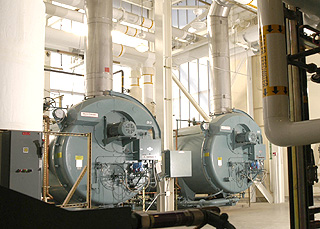
DJC.COM
April 19, 2007
New technologies cut heating, cooling costs
CDi Engineers

Brown
|
Notice how much faster those dollar numbers spin around when you fill up your gas tank lately? The same rising energy costs are hitting hospitals where it hurts — in operational expenses — putting a big dent in budgets.
The problem is exacerbated by the amount of energy hospitals use — between two and three times more than a typical office building — because they run 24/7. The higher demand on hospitals’ central heating and cooling systems creates great opportunities for energy saving strategies.
Fortunately, hospitals can take advantage of new concepts and technologies in mechanical system design, both for new construction and retrofitting existing facilities.

Photo courtesy of CDi Engineers
New boiler technology and other central plant enhancements are helping local hospitals save as much as $200,000 a year in operational costs. |
Practices now being used in the Pacific Northwest include: hydraulic (computer) modeling of chilled and heating water systems to optimize pumping energy; variable-primary flow chilled water systems; condenser water temperature resets to increase chiller efficiency; and variable speed drives on boiler force-draft blowers.
Put together, these technologies can make the central mechanical system up to 35 percent more efficient — minimizing waste for appreciable bottom-line savings.
Optimizing pumping efficiency
Providence Portland Medical Center has used hydraulic modeling to optimize the cooling equipment pumping system. Using a computer modeling program, engineers can identify where excessive amounts of energy are being consumed.
Another method used to increase energy efficiency is variable flow technology. This reduces flow to the individual system heating and cooling coils to an absolute minimum.
Most existing facilities rely on three-way control valves at the coils, which bypass unneeded heating or cooling water back to the central plant. This makes the plant pumps constantly circulate a steady flow of water, in lieu of pumping only what is needed.
Converting three-way valves to high-quality two-way valves eliminates the unnecessary bypass flow and greatly reduces energy expended by the plant pump. It also makes the central plant chillers much more efficient.
Hydraulic modeling helps engineers justify newer high-quality two-way valves. Savings can be so dramatic that Providence Portland is going back into existing buildings to retrofit three-way valves.
Another major Providence Health System project, still in the planning stages, will include two-way valves in the chilled water and heating water systems. The financial payback for retrofitting old constant-flow systems to new variable flow is two to three years, and often utility rebate programs will assist with funding.
Another way to increase chiller system efficiency is with chillers that use variable speed compressors. Rather than using a mechanical device to throttle the flow of refrigerant in the chiller as the load decreases, chillers outfitted with integral variable-speed drives control the speed of the compressor to match the load.
Valley Medical Center in Renton and Providence Portland have chillers with this technology. While chillers of this type may cost more initially, they trounce their constant-speed cousins in energy consumed at partial-load conditions. This is significant, since chillers function below full capacity 99 percent of the time — explaining why variable-speed compressors typically use only 30 percent of the energy consumed by standard constant-speed chillers.
Temperature resets
Another important breakthrough comes in the form of condenser water temperature resets. Condenser water conveys the “rejected” heat from a chiller to cooling towers located outside the building. The lower the temperature of water returning to the chiller, the more efficient the system.
Since cooling towers are usually sized to accommodate the full design cooling load at severe weather conditions, they are often set to return water at a constant temperature of about 85 degrees to the chillers. When outdoor conditions are less severe, cooling towers can be reset to chill condenser water to a lower temperature, increasing the chiller operating efficiency.
Free cooling
Some facilities are now able to completely shut off their chillers for much for the year by installing “free cooling” heat exchangers.
These transfer cooling energy from condenser water to the chilled water, and work well when outside temperatures are low enough to cool water to between 45 and 50 degrees. In our region, these conditions occur about five months out of the year.
Although hospitals generally have some cooling demand year around, the months when outside conditions permit free cooling generally coincide with times when the building cooling demand is minimal.
Providence Portland had formerly operated chillers all year. After installing a “free cooling” heating exchanger, they were able to shut down their chillers from mid-October through March, resulting in annual savings of $15,000.
Heating system innovations
In older systems, forced-draft blowers on boiler burners operate at a constant speed, and combustion airflow is throttled with a damper as a function of the boiler firing rate.
New variable speed drives on blowers, however, provide only the amount of air that is actually needed. Besides saving energy, the drives help reduce noise in the boiler rooms, can often be applied to existing equipment, and generally pay for themselves in just two years.
In addition to the dollars-and-cents savings mentioned above, local hospitals are finding that central plant efficiencies result in important intangible benefits.
Hospitals are increasingly being expected to demonstrate that they’re responsible stewards of the environment. Opportunities to improve central system efficiencies exist at most older facilities, and result in less source energy being required — plus community recognition that the facility is environmentally conscious. Providence Portland Medical Center recently was awarded the U.S. Environmental Protection Agency’s Energy Star, the national symbol for protecting the environment through superior energy performance.
Better boiler and cooling technology may not make headline news. Yet hospitals can get great PR mileage out of improvement figures, demonstrating with bottom-line data their commitment to greener operating practices.
Norm Brown, PE, is a principal of CDi Engineers in Lynnwood.
Other Stories:
- Wal-Mart can teach hospitals about improving patient care
- Shifting health care needs bring technology to the fore
- Technological transformation is shaking up health care
- Keeping an airborne threat at bay
- Hospitals slowly warming to green design
- Change is coming. Are designers ready?
- Smarter structural design begins with the right analysis
Copyright ©2009 Seattle Daily Journal and DJC.COM.
Comments? Questions? Contact us.